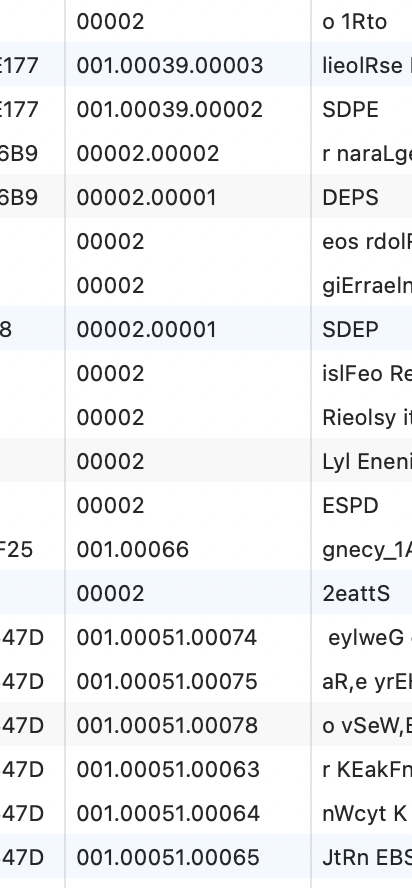- ABP Framework version: v8.2.0
- UI Type: Angular
- Database System: EF Core SQL Server
- Tiered (for MVC) or Auth Server Separated (for Angular): yes/no
- Exception message and full stack trace:
- Steps to reproduce the issue:
Under Administration | Organization Units have a existing Organization Add a couple of Root Units Delete 1 of those Root Units All of the Root Units added are deleted
We are not using MutliTenant. I can see the Root Units in the DB and they are all soft deleted the call to the backend shows just one guid
Request URL: https://localhost:44326/api/identity/organization-units?id=21b23e64-f077-728f-ef0e-3a169f4cf11b Request Method DELETE
Is this by design? If yes can we override this behavior?
22 Answer(s)
-
0
hi
id=21b23e64-f077-728f-ef0e-3a169f4cf11b
Can you check if the id is the id of
TestA? -
0
I have checked, the source code of
Organization Servicehas not been changed for a long time. -
0
hi
id=21b23e64-f077-728f-ef0e-3a169f4cf11b
Can you check if the id is the id of
TestA?Yes it is the id and the other id's that were soft deleted are unique
-
0
hi
I tried to reproduce this problem in https://demo.abp.io/index.html, but I can't reproduce it.
Can you test this in a new template project. if you can reproduce please share the test project with me. I will check it. Thanks.
-
0
maliming,
If i try and create a new solution it does not replicate. if i go to another one of our web apps w/o organizations it doesn't replicate. we have 2 sites with Organization Units, and both show the issue.
if we profile the database we see the following (below). These queries is what we see that are deleting A root unit. does this help, we are thinking something in the abp code is generating these updates to soft delete the root units. does this help??
exec sp_executesql N'SET NOCOUNT ON; UPDATE [AbpOrganizationUnits] SET [ConcurrencyStamp] = @p0, [DeleterId] = @p1, [DeletionTime] = @p2, [EntityVersion] = @p3, [IsDeleted] = @p4, [LastModificationTime] = @p5, [LastModifierId] = @p6 OUTPUT 1 WHERE [Id] = @p7 AND [ConcurrencyStamp] = @p8; UPDATE [AbpOrganizationUnits] SET [ConcurrencyStamp] = @p9, [DeleterId] = @p10, [DeletionTime] = @p11, [EntityVersion] = @p12, [IsDeleted] = @p13, [LastModificationTime] = @p14, [LastModifierId] = @p15 OUTPUT 1 WHERE [Id] = @p16 AND [ConcurrencyStamp] = @p17; ',N'@p7 uniqueidentifier,@p0 nvarchar(40),@p8 nvarchar(40),@p1 uniqueidentifier,@p2 datetime2(7),@p3 int,@p4 bit,@p5 datetime2(7),@p6 uniqueidentifier,@p16 uniqueidentifier,@p9 nvarchar(40),@p17 nvarchar(40),@p10 uniqueidentifier,@p11 datetime2(7),@p12 int,@p13 bit,@p14 datetime2(7),@p15 uniqueidentifier',@p7='2DD45B3F-FC4C-F749-710C-3A16AABE55AD',@p0=N'6998127558414af1ba91d23d7eae1efb',@p8=N'5982a4fcdced4c46b96f30f825e4be3c',@p1='5C9DCA98-2173-FD84-F648-3A13DD86C3AA',@p2='2024-12-05 14:45:07.8682894',@p3=1,@p4=1,@p5='2024-12-0514:45:07.8745836',@p6='5C9DCA98-2173-FD84-F648-3A13DD86C3AA',@p16='84635BED-107A-2839-4C7B-3A16AABE6877',@p9=N'7801f92d8df747819280d309958c8f4c',@p17=N'182ea7d4d3734024873fa2f58f37c7d2',@p10='5C9DCA98-2173-FD84-F648-3A13DD86C3AA',@p11='2024-12-05 14:45:07.8736023',@p12=1,@p13=1,@p14='2024-12-05 14:45:07.8745117',@p15='5C9DCA98-2173-FD84-F648-3A13DD86C3AA' UPDATE [AbpOrganizationUnits] SET [ConcurrencyStamp] = @p0, [DeleterId] = @p1, [DeletionTime] = @p2, [EntityVersion] = @p3, [IsDeleted] = @p4, [LastModificationTime] = @p5, [LastModifierId] = @p6 OUTPUT 1 WHERE [Id] = @p7 AND [ConcurrencyStamp] = @p8 UPDATE [AbpOrganizationUnits] SET [ConcurrencyStamp] = @p9, [DeleterId] = @p10, [DeletionTime] = @p11, [EntityVersion] = @p12, [IsDeleted] = @p13, [LastModificationTime] = @p14, [LastModifierId] = @p15 OUTPUT 1 WHERE [Id] = @p16 AND [ConcurrencyStamp] = @p17 -
0
hi
It would be best if you could provide the code and steps to resolve this problem.
The SQL query is generated by code. I have to check the source code.
liming.ma@volosoft.com
Thanks.
-
0
Ok, will email you the github address and some sample data
-
0
hi
Thanks. I will check the
OtisEd.Artifact.Angularproject. -
0
hi
I have tested, but I am unable to reproduce.
See my test videos(two): https://we.tl/t-Sk902jj9Qh and https://we.tl/t-G7hc8aBHpN
-
0
sent you a video in your email, file would not attach
essentially i just created 2 root nodes with nothing underneath them, and then deleted one of them
-
0
hi
Please do this:
- enable the debug logs for Microsoft and EF Core and output the logs to a
logs.txtfile.
"Logging": { "MinimalLevel": "Information", "EnableConsole": true, "EnableDebug": true, "EnableLocal": true, "Overrides": { "Abp": "Debug", "Elastic": "Warning", "Hangfire": "Warning", "HealthChecks": "Warning", "IdentityServer4": "Warning", "Microsoft": "Debug", "Microsoft.EntityFrameworkCore": "Debug", "OpenIddict": "Warning", "System.Net.Http.HttpClient": "Warning", "Volo": "Information" } },- remove all
ou - add two root
ou - try to remove one and see the result.
if you still have a problem, Please share your
logs.txtwith liming.ma@volosoft.comThanks.
- enable the debug logs for Microsoft and EF Core and output the logs to a
-
0
I
- deleted all org units using the app, they were soft deleted
- i added 2 root nodes
- i deleted 1 root node and only 1 was deleted
But when we have org units and then add the 2 root nodes (w/out children), all toot nodes w/out children are removed.
In the video i sent you, it has org units already, then i added the root nodes. this is the only way we can reproduce it
-
0
hi
Can you share the debug logs(https://abp.io/support/questions/8428/All-Organization-Root-Units-deleted-when-deleting-just-one-unit#answer-3a16c0bc-bdcf-b99b-78e3-ad1a6afd5a74) of these steps?
I will check the SQL statement from your logs.
Thanks.
-
0
-
0
Thanks. I will check it. you can share file via https://wetransfer.com/ next time. : )
-
0
hi
I have reproduced the problem. Checking..
-
0
-
0
I will get back to you tomorrow, hopefully to close this ticket. Your solution works
-
0
:)
-
0
hi
Is your problem solved?
-
0
yes
-
0
Great





